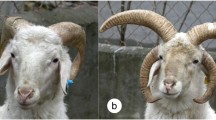Abstract.
Spider Lamb Syndrome (SLS) is a semi-lethal congenital disorder, causing severe skeletal abnormalities in sheep. The syndrome has now been disseminated into several sheep breeds in the United States, Canada, and Australia. The mode of inheritance for SLS is autosomal recessive, making the identification and culling of carrier animals difficult due to their normal phenotype. Two large pedigrees segregating for the SLS mutation were established, and a genome scan with genetic markers from previously published genome maps of cattle and sheep was used to map the locus causing SLS. Genetic linkage between SLS and several microsatellite markers, OarJMP8, McM214, OarJMP12, and BL1038, was detected, thereby mapping the SLS locus to the telomeric end of ovine Chromosome (Chr) 6. Alignment of ovine Chr 6 with its evolutionary ortholog, human Chr 4, revealed a positional candidate gene, fibroblast growth factor receptor 3 (FGFR3).
Similar content being viewed by others
Author information
Authors and Affiliations
Additional information
Received: 10 June 1998 / Accepted: 23 September 1998
Rights and permissions
About this article
Cite this article
Cockett, N., Shay, T., Beever, J. et al. Localization of the locus causing Spider Lamb Syndrome to the distal end of ovine Chromosome 6. 10, 35–38 (1999). https://doi.org/10.1007/s003359900938
Issue Date:
DOI: https://doi.org/10.1007/s003359900938




